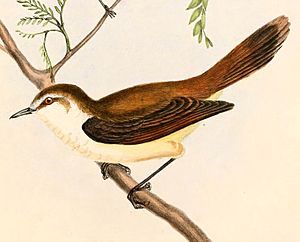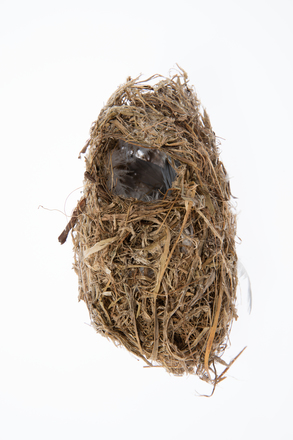Chatham gerygone facts for kids
Quick facts for kids Chatham gerygone |
|
|---|---|
 |
|
| Conservation status | |
| Scientific classification | |
| Genus: |
Gerygone
|
| Species: |
albofrontata
|
 |
|
The Chatham gerygone, also called the Chatham Island warbler, is a small bird. Its scientific name is Gerygone albofrontata. This bird belongs to the Acanthizidae family, which includes many small, insect-eating birds.
The Chatham Island warbler lives only on the Chatham Islands, a group of islands off the coast of New Zealand. This means it is an endemic species. It is related to the grey warbler, which lives on mainland New Zealand. The Chatham Island warbler is bigger than the grey warbler. Its feathers look different for males, females, and young birds. Both warblers were first described and named by G. R. Gray in 1845. These two warblers are the only birds from their family found in New Zealand.
Contents
What Does the Chatham Warbler Look Like?
The Chatham Island warbler has a plain olive-brown head and back. Its belly is off-white, with pale yellow on its sides and under its tail.
Male, Female, and Young Birds
Male warblers have a special look. They have a bright white forehead, white eyebrows, a white throat, and white underparts. Female warblers do not have these white areas. Instead, their underparts are dull greyish-white. They also have yellow eyebrows, cheeks, and throat. Both adult birds have red eyes.
Young warblers look a bit like the females. Their upper parts are olive-grey. They have more yellow on their underparts. Young birds also have brown eyes.
Size and Weight
Adult Chatham Island warblers are about 12 cm (4.7 in) long. That's about the length of a pen. Male warblers are a bit heavier than females. Males usually weigh about 10 g (0.35 oz). Females weigh around 8.5 g (0.30 oz).
Their Special Song
The Chatham Island warbler has a soft and complex call. Its song sounds similar to a young grey warbler's song. It often starts with four notes that repeat. This unique call was important to the Māori. They used it as a sign to know when to plant their crops.
Where Do Chatham Warblers Live?
These warblers naturally live in temperate forests. They are common in the southern forests of the main Chatham Island. You can also find them on nearby islands. These include Pitt Island, Little Mangere Island, Star Keys, and Rangatira.
The warblers are not found as far north on the main island. This is mainly because of habitat loss and predators.
How Do Chatham Warblers Live?
The Chatham Island warbler eats small insects. Their diet includes caterpillars, flies, and beetles. They also enjoy eating spiders.
Feeding Habits
They mostly find their food high up in the trees. They pick insects off leaves and from cracks in tree branches. Sometimes, they also look for food in the fallen leaves on the ground. Unlike the grey warbler, the Chatham Island warbler does not hover in the air to catch insects.
Nest Invaders
Sometimes, Shining Bronze-cuckoos lay their eggs in the warblers' nests. This is called nest parasitism. The cuckoo chick hatches first. It then pushes the warbler eggs out of the nest. The adult warblers then feed and raise the cuckoo chick as their own.
Threats to the Warblers
Other dangers to the Chatham Island warbler include rats and cats. The biggest threat, however, is the loss of their forest homes.
How Do Chatham Warblers Breed?

Chatham Island warblers build their nests alone. They have special areas called territories that they protect from other warblers. Male birds usually handle these arguments. You might see long chases when another bird tries to enter their space. Even though they are very protective, these birds never actually fight each other.
Family Life
These warblers are monogamous. This means they stay with the same partner for breeding. They have been known to defend the same breeding territory for up to three years in a row.
Nesting Season
The breeding season for these warblers changes each year. It usually lasts from September to January. Their nests are shaped like an enclosed hanging basket. This is very similar to the nests of grey warblers.
Only the female bird builds the nest. She uses materials like moss, lichens, leaves, bark, feathers, small twigs, and spider webs. The inside of the nest is lined with soft feathers. The location of the nests can be different depending on the island. On the largest island, nests often hang freely in open spaces. On the smaller islands, nests are usually hidden in thick plants.
Raising Chicks
The female warbler sits on the eggs to keep them warm. Her eggs are an off-white color with small reddish-brown spots. Once the chicks hatch, both the male and female birds help feed them. The Chatham Island warbler has a very high breeding success rate of 87%. This is much higher than the grey warbler on the mainland, which only has a 38% success rate.
Protecting the Chatham Warbler
The Chatham Island warbler population is doing well in places without predators. There are an estimated 5000 adult birds. Even though their numbers are thought to be slowly decreasing, they are not yet considered "vulnerable" by the IUCN. This means they are listed as "least concern" on the red list of threatened species.
However, a recovery plan is in place in New Zealand. This plan aims to help the warblers because their homes are being lost. Efforts include bringing warblers back to northern parts of Chatham Island. They are also planting new trees to create future homes for the birds. Controlling pests like cats and weka is also a focus. However, these birds mostly live in the treetops, so they are not often affected by these ground predators.
See also
 In Spanish: Gerygone albofrontata para niños
In Spanish: Gerygone albofrontata para niños


